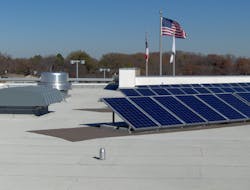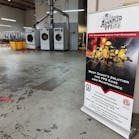Is the power really off? One of the common tasks assigned at the scene of a structure fire is to secure the utilities. This is typically done by disconnecting the water, gas, and electric services to the facility. This article will discuss how renewable energy sources are tied into a building system and how renewable sources can compound the issues of ensuring the power is off.
The electric service to a building is typically secured be moving the main breaker or the main fusible disconnect to the off position. If this cannot be done safely, another common method is to have the utility company disconnect the power to the building. In most residential (and some commercial) settings this will eliminate the flow of electricity through the building. However, when renewable on-site energy sources and generators are present, this is not always the case.
I think it would be helpful to discuss some of the various renewable energy sources that currently exist and evaluate in depth a couple of the more complex systems. Due to lower installation costs, a desire to be green, a large range of both tax and utility company incentives and higher utility costs, many building owners are choosing to use renewable energy sources. Generally speaking, I define a renewable energy as one that does not require electric, fossil fuels (oil, natural gas, propane) or treated water from the utility to provide energy to a facility.
One very basic renewable energy source that we see every day, and which will be the basis for much of this discussion, is solar panels. Solar panels obviously collect their energy from the sun and are generally used for two purposes, one is to produce electricity (photovoltaic) and the second is to produce hot water (solar thermal). Some other sources of renewable energy are wind turbines, which collect their power from the wind and turn it into electric and geothermal (where water is pumped thorough wells in the earth and the water accepts and rejects heat to the water). Many facilities are also installing irrigation systems that collect rainwater in large storage vessels and use the rainwater to irrigate the property. Some other renewable sources that exist, but are not as common on a small scale, include biomass, hydrogen, and hydropower.
Solar Thermal
The focus of my discussion this month is the use of solar energy, how it is used in buildings and how it can impact firefighting operations and the safety of fire fighters. We’ll start with solar thermal, which sounds more complicated that it is. There are generally two types of solar thermal systems — active and passive. Basically, one uses a pump and one does not. However, from a firefighting standpoint, the type of system is not important. Solar thermal really boils down to water flowing though solar collectors and absorbing the energy from the sun and thus raising its temperature. The water heated from the sun either flows directly into the tank and the water in the solar collectors is replaced with new water (passive system), or the water flows through a coil in the tank rejects the heat to the tank water and returns to the solar collectors (active system).
The bottom line for firefighters with a solar thermal system is two-fold. One is a large water tank in a mechanical room, which may be on an upper level. Firefighters need to know about this weight if the fire impacts the structure supporting this tank. This is a very important consideration that needs to be remembered when operating in commercial structures. The second, and more obvious, issue with any solar panel, including solar thermal, is the solar panels themselves. The panels may cover large areas of the roof and may make vertical ventilation difficult. You may also see these panels mounted to the side of the building as well. This may make access to windows and other upper-level openings difficult and creates another piece of debris to fall from the building.
Photovoltaic Systems
Photovoltaic systems present some unique challenges of their own. Photovoltaic systems take the energy from the sun and convert it into electricity. The power that is created direct current and through an inverter is converted into alternating current and used in the facility for specific circuits, or ties directly back into the utility power. Firefighters need to be aware of how buildings with these systems are tied into the electric system. In many instances, these systems are tied back into the buildings overall electrical system in a way that allows the solar power to provide power to a circuit and allow normal building power to power the circuit as well in times when the sun is not providing enough energy. This is where there is a large concern for firefighters.
As firefighters know, or should know, electricity flows through a conductor through the path of least resistance, so it can flow both ways. In many commercial fires one of the tasks for arriving companies is to secure the utilities. In the case of photovoltaic, even if the main power source for a facility is disconnected, power may flow from the inverter back though the system and energize what is thought to be a de-energized system. Therefore, when securing the utilities it is important that firefighters identify the source of the power from the photovoltaic system and disconnect that as well. This may be difficult if you are in a building for the first time and have no idea where it may be located. In some jurisdictions, however, the utility companies and code enforcement authorities have required the installation of a disconnect outside of the facility near the meter to disconnect the solar power from the buildings electrical system.
Another concern to firefighters is the solar panels themselves. Much like the solar thermal panels, these panels block access to the roof and are generally tied into the building structure or ballasted down and not easy to move, making vertical ventilation nearly impossible. As discussed with solar thermal panels, photovoltaic panels are also mounted on the exterior walls of building, making access to windows difficult and creating a significant falling-debris hazard.
Generators
Lastly, I want to briefly address emergency generators. This is a topic that I will devote more time to in a future article; however I encourage you to find out what buildings in your response area have generators and how they are tied into the overall electrical system. Most systems today have automatic transfer switches that automatically start the generator when there is a loss of normal power. If the team assigned to secure the utilities simply opens the disconnect they may be turning off the utility power, but they are starting the flow of power from the generator, negating the effect of disconnecting the power. We will discuss this more next month.
Renewable energy sources are becoming more popular in today’s commercial buildings. Firefighters need to recognize these systems and understand the difficulties they may cause with vertical ventilation and securing the electric. Firefighters also need to be aware of the large storage tanks that may be installed with solar thermal systems. As always, keep up with the construction and renovation in your response area and try to seek out as much knowledge as you can before you need it.
MATTHEW STIENE, a Firehouse.com Contributing Editor, is the Senior Facility Manager for the Mecklenburg County Real Estate Services Department, in Charlotte NC. Matt possesses a Master of Engineering degree in Fire Protection Engineering from the University of Maryland, and a Bachelor of Science degree in Mechanical Engineering from Clarkson University. He has been in the volunteer fire service for 16 years in both New York and North Carolina, serving three years as chief and has held numerous leadership positions. Matt has worked in the facilities construction and management industry for over 10 years as a consulting engineer, project manager, and facility manager. He is a licensed professional engineer in North Carolina, and is a certified facility manager and certified facility management professional. Matt can be reached at [email protected].

Matthew Steine | Firehouse.com Contributor
Matthew Stiene, PE, is the Senior Director of Plant Engineering for Novant Health in Charlotte NC, where he oversees plant operations, energy management, environmental affairs, and infrastructure capital replacement. Novant Health is an integrated healthcare System of 13 hospitals and 300 physician practices in the southeast. Matt possesses a Master of Engineering degree in Fire Protection Engineering from the University of Maryland, and a Bachelor of Science degree in Mechanical Engineering from Clarkson University. Matt has worked in the facilities construction and management industry for over 14 years as a consulting engineer, project manager, and facility manager. He is a licensed professional engineer in North Carolina, and South Carolina and is a certified facility manager and certified facility management professional. Matt can be reached at [email protected].






